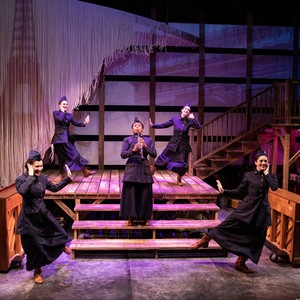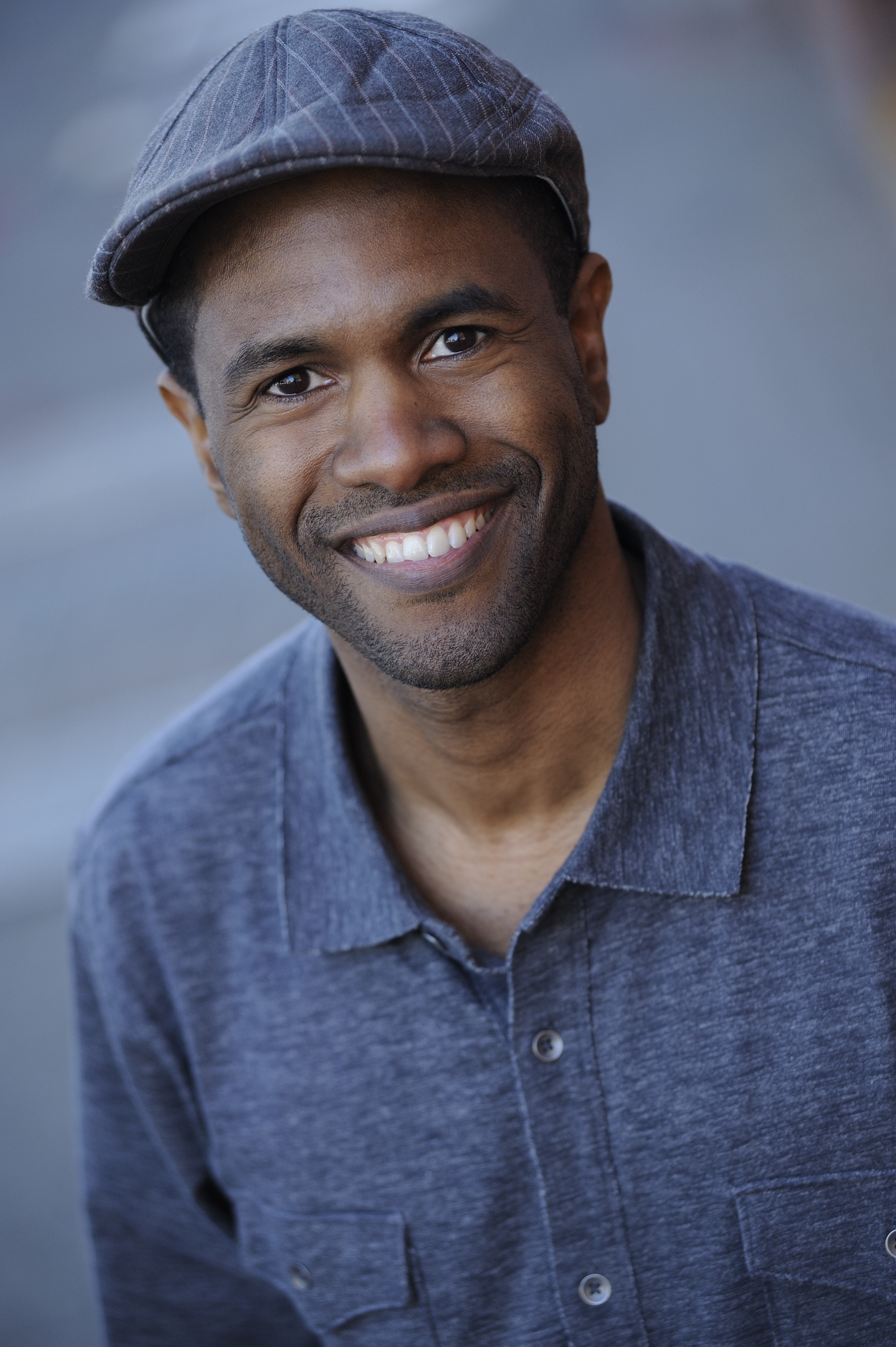
Gabrielle Smith, Bonnie Beus Romney,
and Carmiña Garey
Photo by Reg Madison Photography
Similar to recent films like Hidden Figures, which helped shed light on the virtually unknown stories of how women were involved in important historical events, the musical The Hello Girls introduces us to Grace Barker, the woman who led a group of skilled female switchboard operators serving in the U.S. Army in France during the final battles of World War I. It’s a superb new musical that focuses on this remarkable woman and the dozens of others who were some of the first to break the “glass ceiling” of serving in the Army, even though they barely got any recognition for their efforts. The Phoenix Theatre Company is presenting the regional premiere in a smashing production with a wonderful cast, rich creative elements, and excellent direction, resulting in a moving theatrical experience.
The story focuses on Barker and four of the women who worked for her. Their story is set in motion when General John J. Pershing issues a request for female switchboard operators who are fluent in both English and French to serve in the Army in order to more quickly field calls from the base in Chaumont, France. More than 5000 women applied and 223 served, managing millions of calls during their time. They were dubbed “the hello girls,” a reference to the way they answered the calls: “Hello, how may I connect your call?” Barker was chosen to head up this new division, which was overseen by Captain Riser, the somewhat misogynistic and “by the book” Army man who was assigned to interview and hire the group of women and who often doubted their abilities and didn’t think they should be as close as they were to the enemy lines. The struggle for Barker and the other “girls” to be seen as equals, and to prove they are just as loyal, smart, and patriotic as the men in the Army, is the main focus of the plot. There is also an epilogue that gives facts about the characters after the war and shows how it took years for the women to get the recognition they deserved.
The show premiered in 2018 at Prospect Theater Company, where founders Peter Mills and Cara Reichel were also the show’s creators, with both writing the show’s book, Mills writing the music and lyrics, and Reichel directing. The well-crafted book provides plenty of character development for Barker, the four other “girls,” Riser, and Pershing, and Mills’ score is rich and evocative with witty lyrics and wonderful rhymes in a range of musical styles. Reichel repeats directing duties for the Phoenix Theatre production with fluid movement and layered character portrayals from the wonderful cast.
Grace, played by Rosemarie Chandler, is a force of constant determination, although sometimes she finds herself doubting or second guessing her own abilities. Fortunately, her friend and former co-worker Suzanne is a sounding board and confidante, and Gabrielle Smith exhibits a beautiful amount of strength in that role. Michelle Chin is appropriately innocent and slightly confused as Helen, who hadn’t left her Idaho farm before joining the Army; Carmiña Garey is feisty and fun as the French-born Louise, the 18-year-old who lies about her age so she is able to join; and Bonnie Beus Romney is Bertha, the older, married member of the group who exhibits poise and grace under pressure even though her husband is off fighting the war.
While Riser is the antagonist of the piece, Mills and Reichel’s script beautifully depicts him as a conflicted man and Teddy Ladley does a wonderful job portraying the many layers of Riser. As General Pershing, Scott Wakefield, who created the role in the Prospect Theater production, exhibits a layer of fatherly charm that adds poignancy to the show under a steely military exterior. Alex Crossland, Keiji Ishiguri, and Kevin Robert White portray numerous other characters with ease, with Crossland’s portrayal of the soldier who takes a shine to Suzanne especially heartwarming.
With the exception of just a few instruments, the majority of the cast also double as the orchestra and they are all adept musicians under White’s music direction. Many even play numerous instruments throughout. Reichel’s musical staging exhibits tight choreography as the actors trade off instruments and move set pieces around on Douglas Clarke’s beautiful multi-layer wood set. Clarke uses a mass of cords that evoke telephone wires doubling as a screen for the beautiful projections by Dallas Nichols, which incorporate archival pictures and video to help depict the period and various settings. The choreography by Molly Lajoie is bright, fun, and well danced by the cast. Daniel Davisson’s lighting paints the stage in beautiful images, including a fairly realistic portrayal of a fire, and the costumes by Cari Sue Smith are a wonderful combination of period pieces and modern street clothes used for the modern-day period framing device which helps provide a connection between the past and the present.
The Hello Girls is a refreshing and rewarding musical that sheds light on these unknown women. It’s both a patriotic musical and a lesson in feminism as it honors the first women soldiers in the U.S. Army. It’s also a rich, rousing and enjoyable piece of theater and an eye-opening history lesson.
The Hello Girls runs through January 30, 2022, at The Phoenix Theatre Company, 1825 N Central Avenue, Phoenix AZ. For tickets and information, visit phoenixtheatre.com or by calling 602-254-2151.
Music and Lyrics by Peter Mills; Book by Peter Mills and Cara Reichel
Director/Musical Staging: Cara Reichel
Choreographer: Molly Lajoie
Musical Director: Kevin Robert White
Assistant Director: Elise Palma
Dialect and Language Coach: Pasha Yamotahari
Scenic Designer: Douglas Clarke
Lighting Designer: Daniel Davisson
Video Designer: Dallas Nichols
Sound Designer: Dave Temby
Costume Designer: Cari Sue Smith
Hair + Makeup Designer: Shelby Joiner
Properties Master: Sarah Harris br> Director of Production: Karla Frederick
Stage Manager: Michelle Elias*
Assistant Stage Manager: Maylea Bauers*
Covid Safety Manager: Tatiana Trujillo
Company Manager/Assoc. Production Manager: Tyler Welden
Cast: (in alphabetical order)
Grace Banker: Rosemarie Chandler*
Helen Hill/Dance Captain: Michelle Chin*
Pvt. Eugene Matterson/Others: Alex Crossland
Agnes Coleman: Alicia Ferrin
Louise LeBreton: Carmiña Garey
Pvt. Robert Dempsey/Others: Keiji Ishiguri
Cpt. Joseph Riser: Teddy Ladley
Bertha Hunt: Bonnie Beus Romney
Suzanne Prevot: Gabrielle Smith*
General John Pershing: Scott Wakefield*
Lt. Ernest Wessen/Others: Kevin Robert White*
*Members of Actors’ Equity Association, the union of professional actors & stage managers in the U.S.
This review is by Gil Benbrook for Talkin’ Broadway.









